Multi-Python Castle (with a real past)
ANNETTE ON THE ROAD: Better Leave Doune Castle Before I Taunt You a Second Time
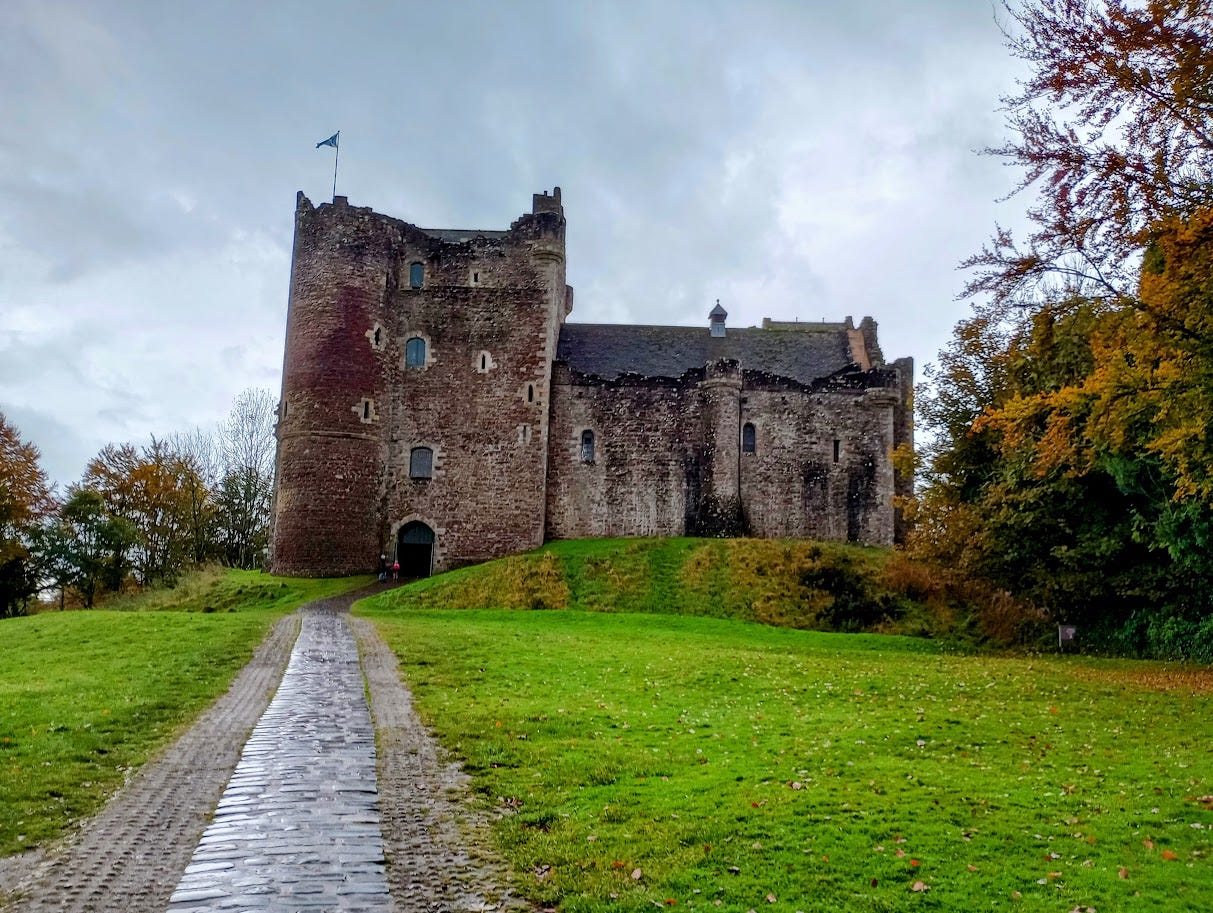
Might as well come clean: I’ve never been a castle fan.
I mean, I love the idea of castles. I love Disney’s adorable theme park castles. But the real deal—and I have visited more than a few, and even slept in one — is not great. At best, they’re awkward freezing places full of tripping hazards, and at worst, and often they’re at their worst, they’re crumbling piles of stone that are scary and even dangerous.
Before health and safety became a British obsession (although still not very successfully addressed, as anyone who’s tried to navigate a British hotel bathroom can testify) my childhood was full of school field trips to ruined castles. I was allowed to stare over the edge of high stone castle walls with little or nothing between me and a quick death.
Oh, and castles were almost always presented with little or no interpretation, no info panels much less visitor centers, so unless you were a self-educated castle expert, or a kid with a great imagination who was happy to rampage around pretending, good luck.
What brought Hoosen and me to Scotland’s Doune Castle (pronounced doon) was not its proper history, but that this place in the Scottish Lowlands was the location of key castle scenes in Monty Python and the Holy Grail (1975).
Don't worry if you're not a Monty Python fan, though. Doune Castle turns out to have real history that has nothing to do with a very silly 1970s film, and it’s well interpreted, explaining life for a very powerful member of the Scottish upper class in the late 1300s, his family, his servants, and his visitors.
Ridiculous though it was, Monty Python and the Holy Grail was written by Cambridge-educated blokes who knew their English legends (especially King Arthur and, of course, the nutty story of the Holy Grail allegedly being brought from Jerusalem to England, which, let's face it, doesn't exactly ring true.)
And at least one of the Python team knew his medieval history very, very well: The late Terry Jones’s degree was in English, but while at Cambridge, he found his interest in history (of course! Much better!), and the Middle Ages in particular. So Doune Castle’s audio tour (free with admission) is narrated by the late Terry Jones, and naturally, it’s very entertaining. When I suggested to young workers at the Castle that, eventually, the audio guide will need to be recorded by someone else (Mr. Jones no longer being with us), they expressed great dismay. I see why.
The Pretendy King
On the audio tour at Doune Castle, Terry Jones does a terrific job, not only of Monty Python reminiscing, but also of telling the real history of Doune Castle, and especially the tale of its most famous resident, Robert Stewart, Duke of Albany.
No, I hadn’t heard of the Duke of Albany either, but as a Scot who grew up in England, and who was taught mostly modern—not medieval—history, I’m not shocked by my own ignorance.
Annette’s Aside: Only in America do we pretend to believe it’s possible to learn “all” history, and if I achieve nothing else at Non-Boring History, it will be to show you how bonkers that is. Why do Americans think this way? Easy: You are taught the US history “survey” over and over, from elementary school to college, using massive textbooks, as if that’s all there is to know, or, at least, that’s the only important stuff. What I’m trying to show you, before academic history is snuffed out, is that you’re being misled.
Not even experts know everything. The textbook is NOT the gold standard of what constitutes history for historians, most “history” in schools is actually “social studies”, taught by people who have never read a history book, much less mastered the discipline of history (sorry, but that’s true) and, just to make me really want to take to drink, we now have a handful of historians making massive fortunes by throwing in the towel and telling you that they are the source of all historical and political wisdom, and that textbook accounts are good enough for riff-raff like you. I am happy to show you bit by bit how very wrong that is. I do not expect to make myself popular.
Doune Castle was where I learned the story of the Robert Stewart, Duke of Albany, the “uncrowned king'“ of Scotland in the late 14th century, and of his castle home. I’m going to tell you a greatly simplified version of Albany’s story, because it’s gobsmackingly confusing otherwise, and I don’t have a good handle on it. Just one example: As is true in British history in general, people in Albany’s story keep changing their bloody names. So I’m just going to call him—as Terry Jones does— Albany.
Albany was the son of the aged King Robert II of Scotland, who, by 1388, was starting to get a bit past his best. So Albany became guardian of his dad, and of the entire kingdom of Scotland, which was based in the Lowlands, the less mountainous area of the country. Doune Castle was halfway between Glasgow and Edinburgh, and about sixteen miles from where the Highlands begin, and, may I say, dramatically so, with a big steep drive up a mountain that I have done many times.
Even after his father died, in 1390, Albany was still in charge: Yes, his brother John Stewart became Robert III (Take a breath—the brother called Robert did NOT become King Robert, because his older brother did). But John/Robert was soon kicked by a horse—hard—and so Albany remained in power as Acting King. Supporters of the next in line for the throne, Albany’s nephew, James, aged 11, realized Albany might try to kill him to get him out of the way, and tried to send him into safety in France, but, as he traveled through England, little James was imprisoned by the English King, who demanded a ransom. Robert III (horse kick dude, and James’s dad)died the very next month. But Albany declined to pay to free his nephew. He may also have eventually murdered his other nephew, James’s brother. This was how Albany was King of Scotland in all but name.
Meanwhile, Albany had built Doune Castle sometime at some point after 1361 . . . Yes, medieval history tends to be a bit vague like that . . . Oh, wait. According to the brand new guidebook (2024), unlike the older audio tour, beardy archaeologists have now discovered that Doune Castle was already there. And long before that early medieval castle, the Romans had built a fort just a few yards away. This is a great lesson in why old buildings in Britain are hard to date, and why you can be 100% sure that none of them now look as they did in the past.
To be fair, Albany gave the place massive improvements, although it’s not entirely clear to me what those were: Archaeologists, like historians, keep moving the goalposts as we all make new discoveries, or rethink what we already know. Albany seems to have added walls to form a courtyard which, today, is soggy lawn, but in his day was dirt. Or cobbles. Or both. Whatever.
And if that’s not complicated enough for you, parts of the Castle and some room features are Victorian renovations from the 1880s. Luckily, these are easier to spot because they look too good. The Victorians didn’t just love the late medieval period: They tried to improve upon it.
Yes, Victorians (especially in the last two decades of the 19th century) were always trying to make castles and churches more medieval and more ornate than they actually had been in the Middle Ages, with cute turrets, carved wooden features, and whatnot. They did this even as they totally wrecked the rest of the landscape with factories, railways, etc. I have to see this as not a coincidence, like Victorian Scots “reviving” Highland culture that their ancestors had destroyed, and making it nicer. Most of what’s sold as Scottish culture to tourists—and, to be honest, Scots themselves, is Victorian rubbish. Sorry. Want to know more? Here you go:
That said, Doune is about as authentically late medieval (state of the art) as a castle gets. Late medieval? Oh, yeah. Modern history is already started by the time 1500 runs around, and life in a castle in 1400 is far, far more advanced than the simple structures of 1300 or 1100.
So here we are, in one of the best preserved castle ruins in all of Scotland. If you point me to others, I will probably have to disappoint you by telling you those are Victorian or even 20th century fakes.
I want to take you through a few glimpses of 14th century life in Doune Castle as I learned about it. And then, as a thank you to my paying supporters, I will talk Monty Python.
An Orcadian Encounter
We entered the castle through the classic archway in the massive gatehouse (big tower), off which the ticket office is housed. A pleasant young man from Orkney (islands to the north of mainland Scotland) and I chatted about our lives as Scots with fluctuating accents, while Hoosen was fascinated, having seen this phenomenon up close as my longsuffering spouse of many years. All I need are visual cues from the architecture as we cross the Border from England, and maybe an encounter with a single Scot, and I’m away: My Scots accent bursts out of its own accord.
My new Orcadian friend (I’m a Dundonian, from Dundee, he’s an Orcadian from Orkney) talked of how his Orcadian accent and words return when he goes home: Orcadian is a branch of Lowland Scots, not Gaelic, and influenced by Scandinavian languages. Orkney folk are closer to Icelanders, genetically speaking. Not that the casual listener to this convo would have a clue: Neither of us was speaking in dialect—these days, fewer people do, more’s the pity,
Albany, the man who made Doune Castle famous, was not a Gaelic speaker, either, but, like me, a Lowlander, a speaker of the Scots language. Oh, and I’m from Pictavia, the land of the mysterious ancient Picts, who lived in northeast Scotland, who lift behind standing stones and whatnot, but no writing we can read. So I’m partly descended from Picts. Not that I have much of a clue what that means, expect it may or may not explain why I was born with red hair. I think probably not.
Into the Kitchen Tower
The Castle isn’t what you would call accessible. Entering the actual buildings requires hiking up a short steep flight of outdoor steps to the door of the Kitchen Tower, where food was prepared and stored, and where servants likely lived. From there, we took a couple more steps into a room called a servery. That’s a British word, meaning a counter or, as in this case, a room, from which food was served.
Here, the castle servants collected dishes from the kitchen through two large serving hatches, and then hurried with them to serve the hungry in the Great Hall. The diners in the Great Hall, the guidebook tells me, may or may not have included the Duke and Duchess of Albany themselves. That’s because, by the late middle ages, the upper classes increasingly preferred to eat privately, being less and less convinced that they needed to eat their dinners in front of riff-raff to maintain power and respect. I suppose the equivalent today would be taking private jets instead of first class seats on airplanes, or living on a private island without neighbors.
Here are the kitchen hatches viewed from the servery, with the kitchen ahead of us, and do note the very informative and colorful info panel, one of many:
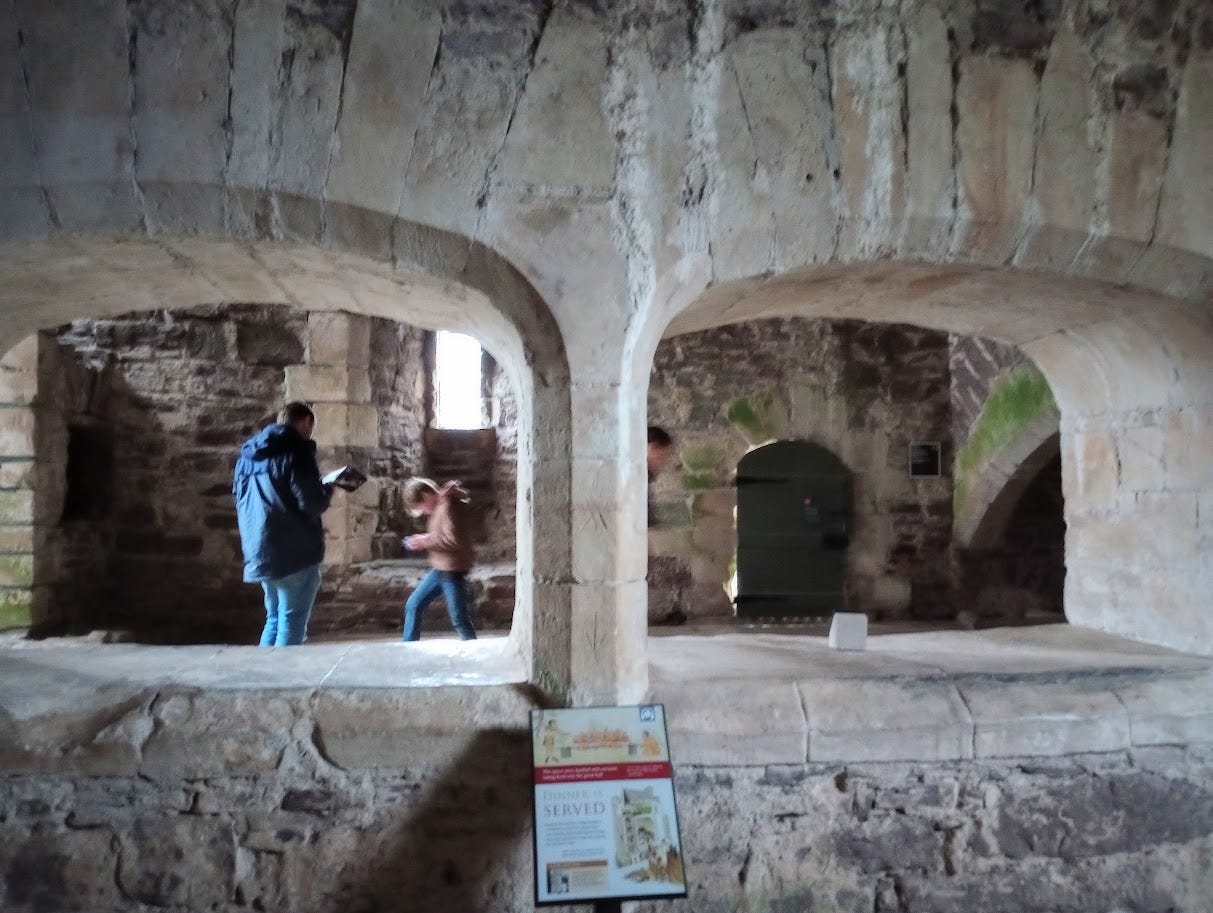
There’s a stone spiral staircase, headed upwards, that opens into the servery. I let Hoosen climb up there without me, because I’m fearful of heights, and I’ve had my fill of terrifying spiral stone staircases from the Middle Ages: My least favorite of the lot, practically crumbling as I walked up it, like in a nightmare, was in St. Mary’s Church in Ashwell, Hertfordshire. I fictionalized it in my novel Don’t Know Where, Don’t Know When, loading it with symbolism, as 1940s foster mother Mrs. Devenish kindly and confidently helps the terrified American time-traveler Hannah navigate it. Let’s just say that it wasn’t hard to empathize with Hannah.
What I just learned from the Doune Castle guidebook was that the stone staircase, which led to what were probably the servants’ small and unheated bedrooms, was originally made from wood. The stone came later:

Before we go see where the kitchen’s food met diners, let’s pop into that kitchen and imagine the cooking action.
Underneath the Arches
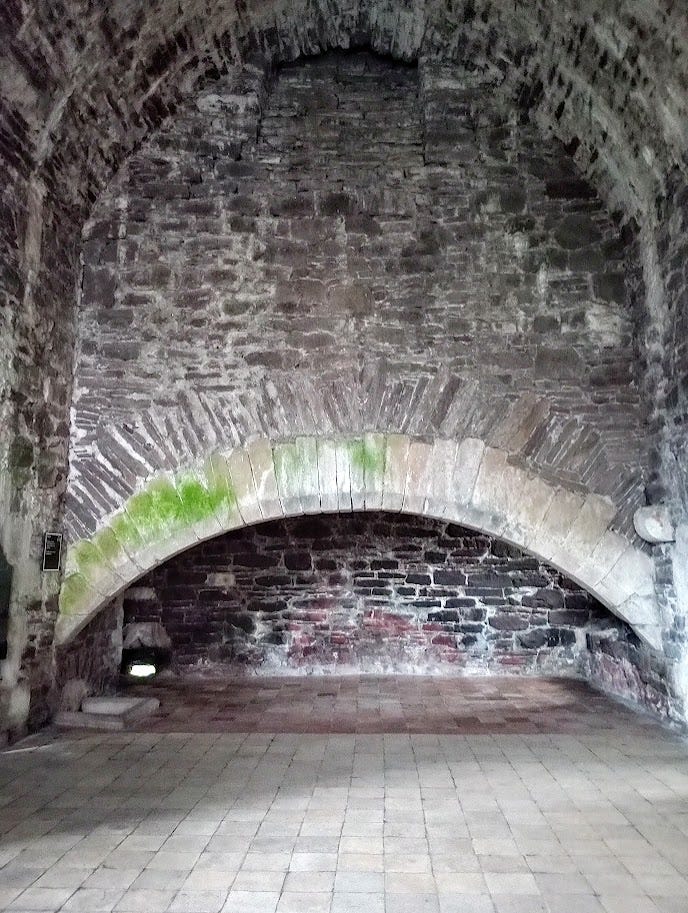
Most actual cooking in the kitchen took place under this archway. That’s because the archway is a massive fireplace. It’s hard to show you the scale without posing someone in the fireplace, but it was big enough not only to turn an entire ox on a spit on an open fire, but to still have lots of room for people cooking other foods over other small fires. Think of this fireplace as a giant stove inside of which which cooks worked, and it’s not hard to imagine this was hot work, indeed.
Terry Jones told me in the audio tour about the bread oven that can still be seen in the wall at the opposite end of the room, but what he didn’t tell me, and which the more recent and more detailed guidebook did, is that the oven is a later addition, probably from the middle of the 18th century.
The guidebook also mentions that there are vents above the whole kitchen, so the main part of the room may not just have been for prep work, but that small fires may have been lit on the paved floor—yes, sure, the paving dates only to the 1880s, but there would have been paving in the 14th century too . . .
Psst . . . I always love all the weasel words that we historians and archaeologists use when we can’t be sure, or simply don’t know, and the further back in time we go, the more weasel words we trot out: may, should, would have, might, etc. We’re brilliant at it!
The glass window is a later addition, possibly replacing shutters. Next to it is a window seat, and historian Dr. Nicki Scott, author of the guidebook, theorizes that pastry chefs doing elaborate pastries might have worked here for the extra light. Hey, makes sense to me. Which doesn’t make it true, but if not, good try.
My favorite sight was near the window: Slashes are carved deep in the stone wall. No, these weren’t made by dragons, or by swords and axes in battle. These were made by prep cooks, sharpening their knives.
While history sold to the public mostly encourages us to pretend that we, too, would have been the rich and powerful, the brave knights and the damsels in distress, knife slashes in stone is the kind of evidence that the overwhelming majority of us leave behind, if anything: Anonymous, fragmentary.
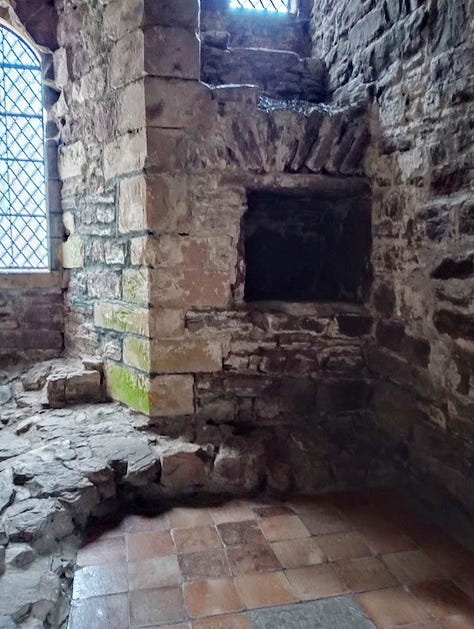
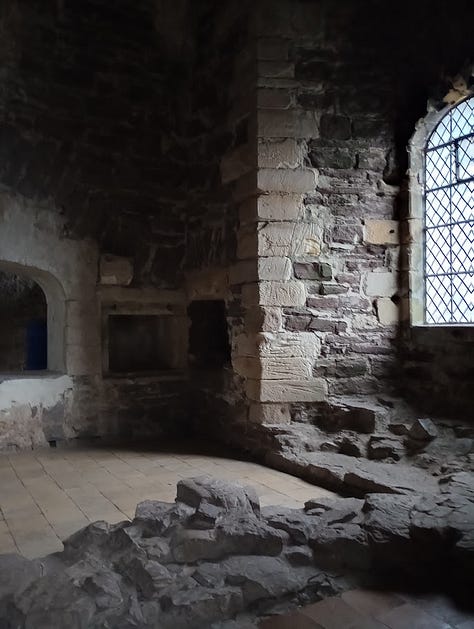
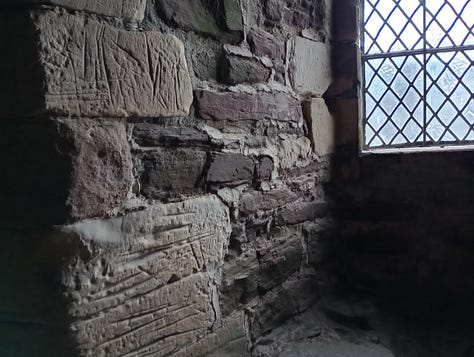
A Pretty Great Hall
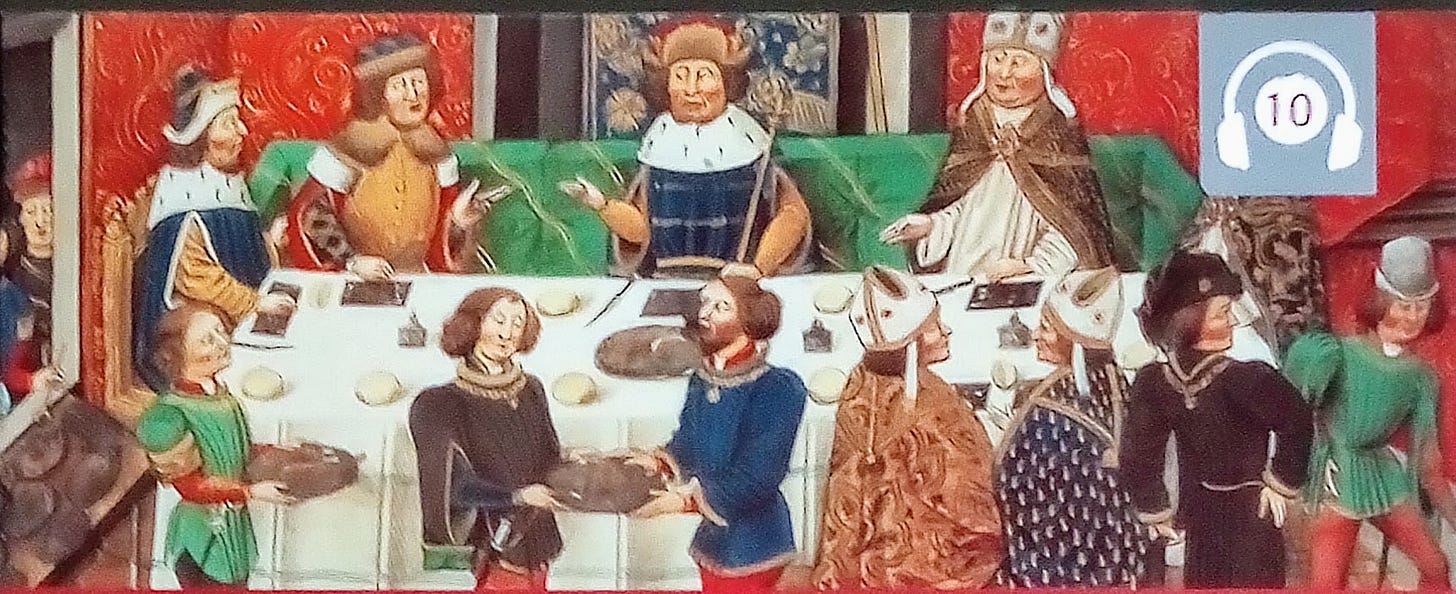
I was very surprised by the elaborate set-up for food service in the Great Hall at Doune Castle. Servants only had to walk a few steps with food from the servery to the Great Hall, where dining took place, only a few yards, so I have no idea why additional prep was necessary.
But servants did indeed further prepare food for serving in a screened-off behind-the-scenes area of the Great Hall. Maybe they were plating it on whatever they were using for plates. Maybe I didn’t consider that plating was a thing because of Hollywood depictions of medieval banquets, as serve-yourself, all you can eat pig-outs, based on the old Hollywood principle of making stuff up. In short: I don’t know how things were in the Great Hall of Doune Castle in 1400, and I doubt even the most expert experts can be sure.
This screened-off area was at the back of the Great Hall below the minstrels’ (musicians’) gallery, which was a Victorian addition, but there had likely been one there in the 14th century, from which music issued to call everyone to dinner, as well as to provide a soundtrack while they ate.
Part of the screened area at the back of the Great Hall was called the buttery. “Buttery” is also the name applied to small cafes in many older English universities, and I (naturally) assumed the name came from butter. But as in most things historical, the obvious answer isn’t true. It probably comes from a French (or maybe Latin) word that has nothing to do with butter, but refers to a storeroom for booze. The buttery was the place where the wine was poured from bottles into decanters, to remove unpleasant sediment. This work was done by men known as—yes!—butlers. How cool is that!
Now the servants carried the food to the Duke and Duchess of Albany and the other diners. The Duke and Duchess (when present in the Great Hall) and important household members and guests sat at the front, on a raised platform, sometimes now called a dais, at a table which, at Oxford, Cambridge, etc is still called High Table.
This was a surprisingly diverse gathering: Servants and ordinary locals also ate in the Hall, at tables arranged according to their importance, although you bet they didn’t get the same food as the richies. Chicken, pork, lamb, and wine, said the info panel, were only for the posh people. The riff raff got beer and beef. Not so bad, though, eh? Oh, and the poshoes had their own loo at the front of the hall which didn’t empty directly over the castle walls, unlike the loos for everyone else. Some poor servant was assigned to clean out the Lord’s and Lady’s loo, so if I made you hungry thinking of medieval food, I guess that’s now no longer a problem.
Meeting Harry and Pauline from 1745
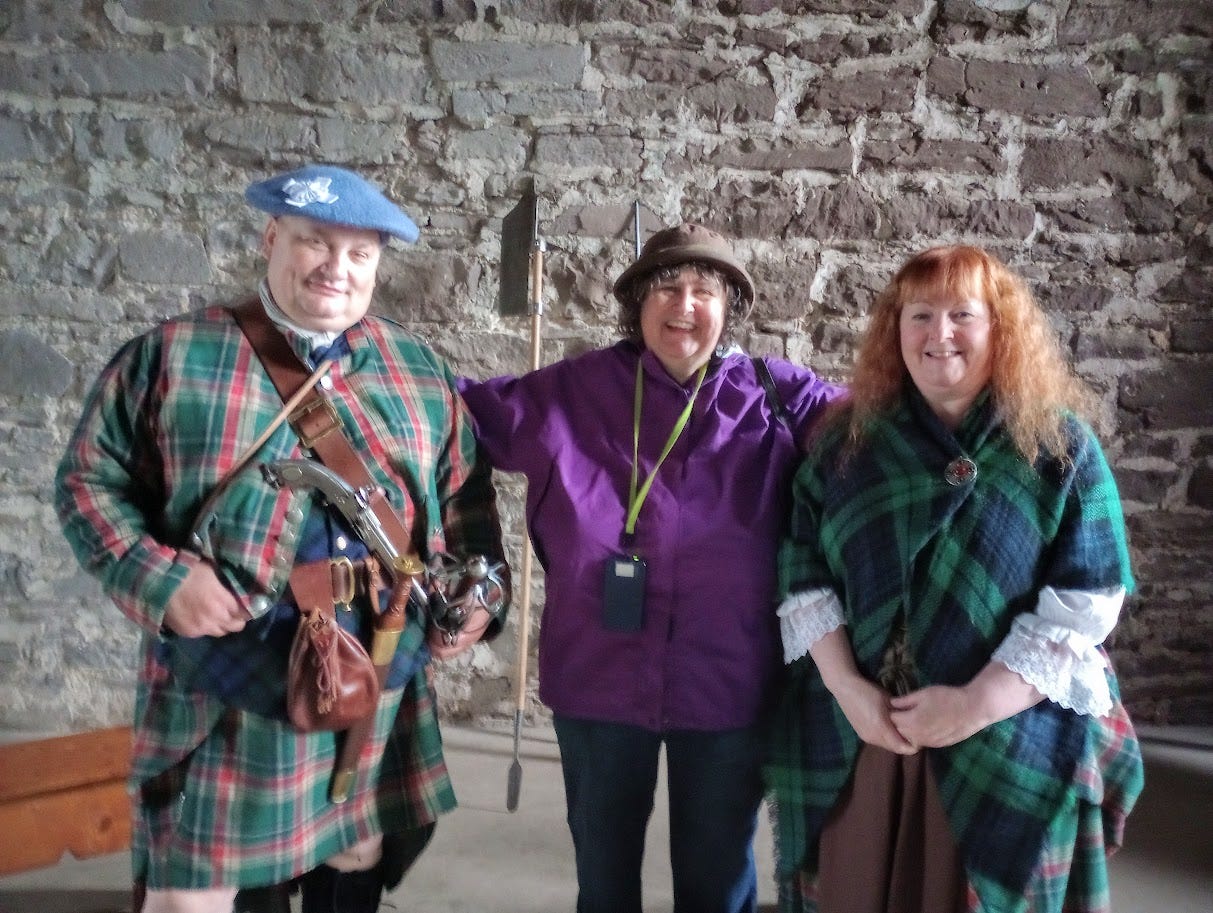
There’s no High Table on the dais today, but instead, there were Harry and Pauline from Aberdeen, historical re-enactors who have a grand time traveling Scotland as part of a troupe of folk in costumes from various periods. Today they were a warrior and an ordinary woman from 1745, the year of the great rebellion in which Scottish Highlanders and Lowlanders fought on both sides (despite national myth) in the war over who would be King of Great Britain: The German Hanoverian monarchs from whom the present Royal Family is descended, or the Stuarts, of Scottish descent, by now led by Charles Edward Stuart, aka Bonnie Prince Charlie, eventually fated to be a lot less bonnie, and to die an impoverished and friendless alcoholic in Rome.
Harry wore a wonderfully transitional outfit somewhere between the traditional plaid, a sort of tartan toga/sleeping blanket, and the modern kilt, an 18th century garment invented by an Englishman who wanted his Highland employees to wear something a bit safer and more practical. Harry demoed a bunch of scary weapons that were carried by ordinary fighters in 1745, including one that looked a bit like the massive blade used to execute the Hippogriff in Harry Potter (likely not a coincidence).
Doune’s Room of Doom
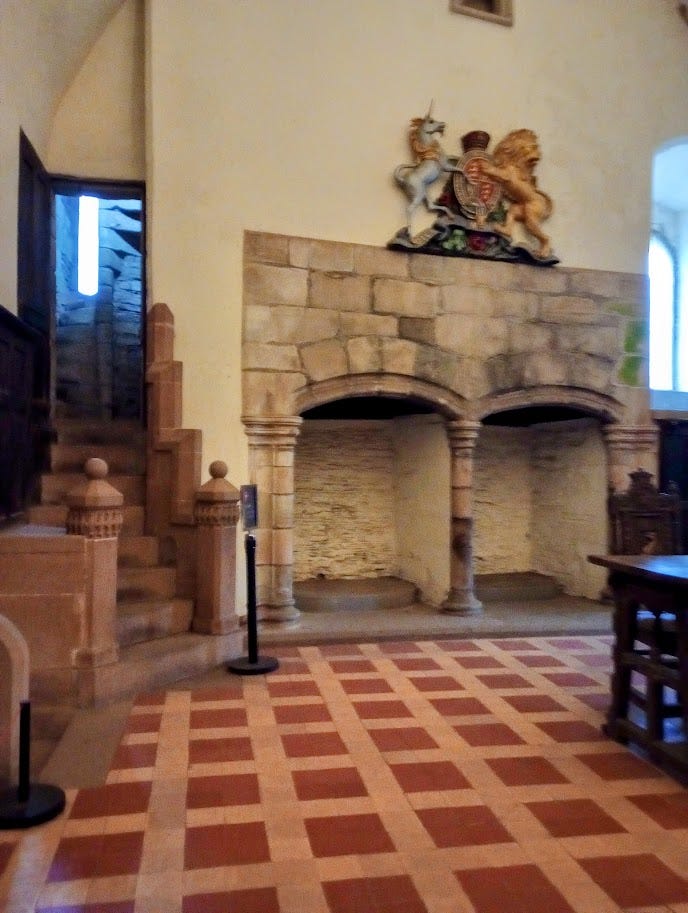
I suddenly realized that I had no choice but to climb up a spiral staircase, or miss the rest of the Castle. The nightmare never ends for me, spiral-staircase-wise. I did manage it, but I’m not sure how, except that I had no choice but to carry on, once I decided to start.
The staircase emerged here, in the room above, that the Victorians had obviously got their hands on. Wall-to-wall carpet? Victorian. The furniture? Not medieval, that was for sure. The coat of arms? Royal, I think, but not medieval. And anyway, officially, the Duke of Albany, while royal, was not the King of Scotland. Except that, in practice, he was. And this was his throne room, and where he dispensed justice, or at least pronounced verdict and sentence.
This was also Albany’s intimate drawing room, where he received guests, so my guess is that a lot of sucking up took place in here, whether from guests or accused wrongdoers. Albany’s unusual double fireplace—pictured— was like having a thermostat: He could light one or two fires as he wished.
And if he found someone guilty? In the next room was a trapdoor from which some poor souls were lowered into a freezing pit dungeon. I’ve seen one of those, as a kid, at St. Andrews Castle in Scotland, where it’s known as a bottle dungeon, since that’s its shape. It was never clear to me how anyone could be brought out, dead or alive, especially if dead or too weak to grab a rope. Or if new prisoners were lowered into a place of dead and decaying bodies. The horror is indescribable.
And now I reflect on how, even in my lifetime, I’ve witnessed remarkable changes in people’s levels of compassion, especially after memories of two horrendous World Wars fade. I often think that if people read what I read, or, worse, experience the things I read, or just extended a bit of empathy, the world might be a very different place. Yet, people can witness horrific things, and come away without caring about the victims. Reading history or, better, autobiography and literature, gives us a better chance at developing our humanity . . . and then, I think, no, it has to be reading that somehow forces us to realize that we could be the person or people on the page. I find people most push back when I ask them to see others as themselves, no matter who those others are. So I’m not sure what the formula for compassion is. I wish I did. It certainly wasn’t present in Robert Stewart, the ruthless Duke of Albany, Scotland’s de facto king, and master of Doune Castle.
A bonus section on Monty Python and Doune follows as a thank—you to Nonnies, paying subscribers. Substack was intended as a platform for writers to get compensated for their work, and not just celebs (and their ghost writers), either. As AI and grifting get their way more and more, please support writers: If not me, then support others. If you don’t, then readers—all of us— face a bleak future.


